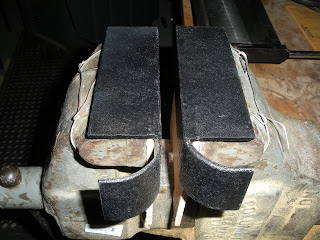
The Fly Baby. Its the plane in the middle :-)
The Fly Baby specs:
Model: 1A
Length: 18 feet 10 inches
Height (folded): 6 feet 11 inches
Wing span: 28 feet
Wing cord: 4 feet 6 inches
Empty weight: 605 pounds
Gross weight: 925 pounds
Fuel: 12-16 gallons
Power 65-85 hp
Cruising speed 110-115 mph
Rate of climb: 850-1100 fpm
Construction: wood and fabric
Airfoil: NACA 4412
Leo's Fly Baby, in his garage
Leo's plane looks quite different from the one in the first photo. You can see the many tools and parts that are required to build an airplane. Fortunately, one of the characteristics of an airplane builder is that he likes tools, and enjoys flipping through catalogues for ones he doesn't have but will probably need. And like most guy things, the best tools are always the loudest (A.K.A. air tools, etc).
This photo shows the fuselage on the right, upside down with the landing gear sticking up. To the left are the uncovered left and right wings. One wing is hanging from the ceiling on a pulley system so he can hoist it up to get it out of the way when not needed.
Because the construction is all wood, Leo's home airplane project complements the work he does on the Aeronca Training Glider. He brings to us an abundance of info, tips, and techniques which shortens our learning curve and speeds the project along.
Hopefully, in the fall when the temperature is cooler, Leo is going to have us over to see the project in person.
By the Leo, have you named your plane yet? Gertrude, Louise, Marilyn (as in Monroe) . . . ?



















































